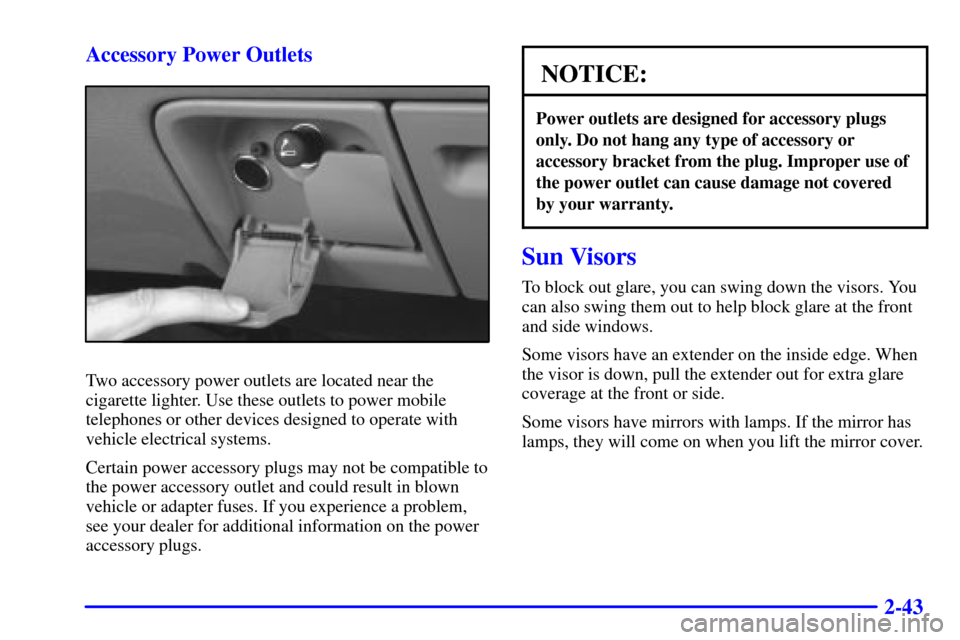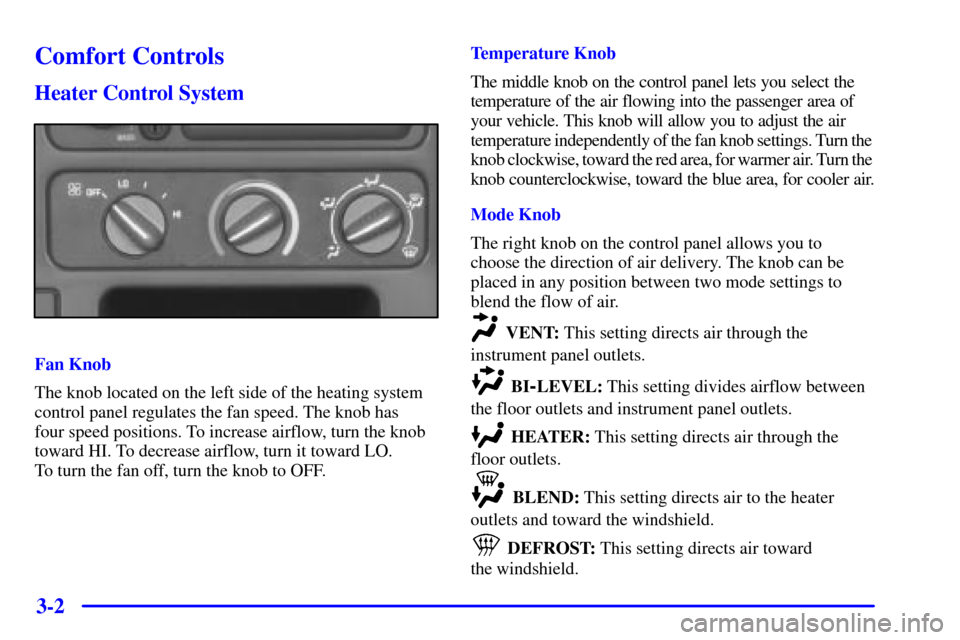Page 80 of 321
2-31 Windshield Washer
At the top of the lever,
there's a paddle with the
word PUSH on it. To spray
washer fluid on the
windshield, push the paddle.
CAUTION:
In freezing weather, don't use your washer until
the windshield is warmed. Otherwise the washer
fluid can form ice on the windshield, blocking
your vision.
Washer fluid will spray as long as you push the paddle.
When you let go of the paddle, the wipers will continue
to wipe for a few seconds and then either stop or return
to the preset speed.
The use of a hood
-mounted air deflector may adversely
affect windshield wiper and washer performance.
Cruise Control (If Equipped)
With cruise control, you can
maintain a speed of about
25 mph (40 km/h) or more
without keeping your foot
on the accelerator. This can
really help on long trips.
Cruise control does not
work at speeds below about
25 mph (40 km/h).
When you apply your brakes, the cruise control shuts off.
Page 84 of 321

2-35
Turn the knob clockwise to the parking lamp symbol, to
turn on the following:
�Parking Lamps
�Sidemarker Lamps
�Clearance Lamps
�Taillamps
�License Plate Lamps
�Instrument Panel Lights
Turn the knob clockwise again to the master lighting
symbol to turn on all the lamps listed as well as
the headlamps.
Turn the knob counterclockwise, to OFF, to turn off
your lamps.
You can turn your headlamps from high to low beams
by pulling on the turn signal/multifunction lever.
Headlamps On Reminder
A tone will sound when your headlamps are turned on
and the key is turned to OFF, LOCK or ACCESSORY.
If you need to use your headlamps when the key is
turned to OFF, LOCK or ACCESSORY, the buzzer can
be turned off by turning the thumbwheel next to the
parking lamp/headlamp knob all the way down.
Daytime Running Lamps
Daytime Running Lamps (DRL) can make it easier for
others to see the front of your vehicle during the day.
DRL can be helpful in many different driving
conditions, but they can be especially helpful in the
short periods after dawn and before sunset. Fully
functional daytime running lights are required on all
vehicles first sold in Canada.
The DRL system will make your headlamps come on
at a reduced brightness when the following conditions
are met:
�the ignition is on,
�the headlamp switch is off and
�the parking brake is released.
When the DRL are on, only your headlamps will be on.
The taillamps, sidemarker and other lamps won't be on.
Your instrument panel won't be lit up either.
When it begins to get dark, your DRL indicator light is a
reminder to turn your headlamp knob on. The other lamps
that come on with your headlamps will also come on.
Page 92 of 321

2-43 Accessory Power Outlets
Two accessory power outlets are located near the
cigarette lighter. Use these outlets to power mobile
telephones or other devices designed to operate with
vehicle electrical systems.
Certain power accessory plugs may not be compatible to
the power accessory outlet and could result in blown
vehicle or adapter fuses. If you experience a problem,
see your dealer for additional information on the power
accessory plugs.
NOTICE:
Power outlets are designed for accessory plugs
only. Do not hang any type of accessory or
accessory bracket from the plug. Improper use of
the power outlet can cause damage not covered
by your warranty.
Sun Visors
To block out glare, you can swing down the visors. You
can also swing them out to help block glare at the front
and side windows.
Some visors have an extender on the inside edge. When
the visor is down, pull the extender out for extra glare
coverage at the front or side.
Some visors have mirrors with lamps. If the mirror has
lamps, they will come on when you lift the mirror cover.
Page 94 of 321
2-45
The main components of your instrument panel are the following:
A. Dome Override Button
B. Exterior Lamp Controls
C. Air Outlets
D. Multifunction Lever
E. Instrument Panel Cluster
F. Gearshift Lever
G. Audio System
H. Comfort Control System
I. Glove BoxJ. Fuse Block
K. Hood Release
L. Parking Brake Release
M. Tilt Lever (If Equipped)
N. Storage Area (If Equipped)
O. Accessory Power Outlets
P. Cupholder
Q. Ashtray
Page 100 of 321

2-51 Anti-Lock Brake System Warning Light
With the anti-lock brake
system, this light will come
on when you start your
engine and may stay on
for several seconds.
That's normal.
If the light stays on, or comes on when you're driving,
your vehicle needs service. If the regular brake system
warning light isn't on, you still have brakes, but you
don't have anti
-lock brakes. If the regular brake system
warning light is also on, you don't have anti
-lock brakes
and there's a problem with your regular brakes. See
ªBrake System Warning Lightº earlier in this section.
The anti
-lock brake system warning light should come
on briefly when you turn the ignition key to RUN. If the
light doesn't come on then, have it fixed so it will be
ready to warn you if there is a problem.
Engine Coolant Temperature Gage
This gage shows the engine
coolant temperature.
It also provides an indicator of how hard your vehicle is
working. During a majority of the operation, the gage
will read 210�F (100�C) or less. If you are pulling a
load or going up hills, it is normal for the temperature to
fluctuate and approach the 260�F (125�C) mark. If the
gage reaches the 260�F (125�C) mark, it indicates that
the cooling system is working beyond its capacity.
See ªEngine Overheatingº in the Index.
Page 105 of 321
2-56
NOTICE:
Damage to your engine from neglected oil
problems can be costly and is not covered by
your warranty.
Oil pressure may vary with engine speed, outside
temperature and oil viscosity, but readings above the
low pressure zone indicate the normal operating range.
A reading in the low pressure zone may be caused by
a dangerously low oil level or some other problem
causing low oil pressure. Check your oil as soon
as possible.
Security Light
This light will come on
briefly when you turn the
key to START.
The light will come on for five seconds after the key is
turned to ON and then go off. If the light flashes, the
Passlock
� System has entered a tamper mode. If the
vehicle fails to start, see ªPasslockº in the Index.
If the light comes on continuously while driving and
stays on, there may be a problem with the Passlock
System. Your vehicle will not be protected by Passlock,
and you should see your GM dealer.
Page 108 of 321
3-
3-1
Section 3 Comfort Controls and Audio Systems
In this section, you'll find out how to operate the comfort control and audio systems offered with your vehicle.
Be sure to read about the particular systems supplied with your vehicle.
3
-2 Comfort Controls
3
-4 Air Conditioning
3
-4 Heating
3
-4 Defogging and Defrosting
3
-5 Ventilation System
3
-6 Audio Systems
3
-6 Setting the Clock3
-7AM-FM Stereo
3
-9AM-FM Stereo with Cassette Tape Player
(If Equipped)
3
-12 Understanding Radio Reception
3
-12 Tips About Your Audio System
3
-13 Care of Your Cassette Tape Player
3
-14 Fixed Mast Antenna
Page 109 of 321

3-2
Comfort Controls
Heater Control System
Fan Knob
The knob located on the left side of the heating system
control panel regulates the fan speed. The knob has
four speed positions. To increase airflow, turn the knob
toward HI. To decrease airflow, turn it toward LO.
To turn the fan off, turn the knob to OFF.Temperature Knob
The middle knob on the control panel lets you select the
temperature of the air flowing into the passenger area of
your vehicle. This knob will allow you to adjust the air
temperature independently of the fan knob settings. Turn the
knob clockwise, toward the red area, for warmer air. Turn the
knob counterclockwise, toward the blue area, for cooler air.
Mode Knob
The right knob on the control panel allows you to
choose the direction of air delivery. The knob can be
placed in any position between two mode settings to
blend the flow of air.
VENT: This setting directs air through the
instrument panel outlets.
BI-LEVEL: This setting divides airflow between
the floor outlets and instrument panel outlets.
HEATER: This setting directs air through the
floor outlets.
BLEND: This setting directs air to the heater
outlets and toward the windshield.
DEFROST: This setting directs air toward
the windshield.